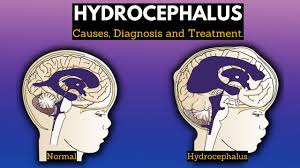Hearing that your baby might have hydrocephalus can be overwhelming. For parents in New Jersey, understanding this condition, recognizing early symptoms, and seeking the right treatment can make a significant difference in a child’s development and long-term health.
Hydrocephalus, often called “water on the brain,” is a condition where excess cerebrospinal fluid (CSF) builds up within the brain’s ventricles, increasing pressure inside the head. While it may sound alarming, early diagnosis and advanced treatment options available in New Jersey - especially at specialized centers like NJ Pediatric Neuroscience Institute (NJPNI) - provide excellent outcomes for many infants.
In this comprehensive blog, we’ll cover what hydrocephalus is, its symptoms, causes, and how it’s diagnosed and treated in babies.
What Is Hydrocephalus in Babies?
Hydrocephalus is a condition in which excess cerebrospinal fluid (CSF) accumulates within the brain’s ventricles. Normally, CSF cushions the brain and spinal cord, providing nutrients and removing waste. However, when this fluid cannot drain properly, it builds up, causing pressure that can affect brain growth and function.
Hydrocephalus can be congenital (present at birth) or acquired (develops after birth due to other conditions).
Types of Hydrocephalus:
- Congenital Hydrocephalus:
This form develops before birth, often due to genetic abnormalities or brain malformations such as spina bifida or aqueductal stenosis. - Acquired Hydrocephalus:
Occurs after birth due to infections (like meningitis), head trauma, brain hemorrhage, or tumors. - Communicating Hydrocephalus:
The CSF can still flow between ventricles but fails to be absorbed properly. - Non-Communicating (Obstructive) Hydrocephalus:
A blockage prevents the flow of CSF between brain ventricles.
Causes of Hydrocephalus in Babies
Understanding what causes hydrocephalus can help in early detection and prevention when possible. Common causes include:
- Genetic abnormalities that affect brain development.
- Brain infections such as meningitis or encephalitis.
- Premature birth, which can lead to brain hemorrhages.
- Tumors or cysts obstructing CSF pathways.
- Spina bifida, where part of the spinal cord doesn’t develop properly.
- Intraventricular hemorrhage, often seen in premature infants.
While not all cases can be prevented, early prenatal care and regular pediatric evaluations can help identify risk factors early.
Common Symptoms of Hydrocephalus in Babies
Hydrocephalus symptoms can vary depending on the child’s age and the condition’s severity. Since babies’ skull bones haven’t fully fused, one of the earliest signs is a rapidly growing head circumference.
Early Signs to Watch For:
- Rapid head growth (head size increasing faster than normal)
- Bulging soft spot (fontanelle) on the top of the head
- Downward deviation of the eyes (also called “sunsetting eyes”)
- Vomiting and irritability
- Seizures
- Poor feeding or difficulty sucking
- Sleepiness or lethargy
- Developmental delays
If you notice any of these signs, it’s crucial to consult a pediatric neurologist or neurosurgeon in New Jersey immediately.
How Hydrocephalus Is Diagnosed
Early and accurate diagnosis is key to managing hydrocephalus effectively. Pediatric specialists at NJ Pediatric Neuroscience Institute use advanced neuroimaging and diagnostic tools to evaluate infants suspected of having hydrocephalus.
Diagnostic Procedures Include:
- Ultrasound:
Used for newborns since their fontanelle allows a clear image of brain ventricles. - Magnetic Resonance Imaging (MRI):
Provides detailed images of brain structure, helping identify blockages or abnormalities. - CT Scan:
Useful in emergencies for quick brain imaging. - Neurological Evaluation:
Doctors assess reflexes, motor skills, and developmental progress.
These diagnostic methods help determine whether hydrocephalus is present and guide treatment planning.
Treatment Options for Hydrocephalus in Babies
Pediatric hydrocephalus treatment requires medical intervention to relieve pressure on the brain and restore normal CSF flow. Treatment typically involves surgical procedures performed by pediatric neurosurgeons.
1. Ventriculoperitoneal (VP) Shunt
The most common treatment is VP shunt surgery, where a small flexible tube (shunt) is inserted to drain excess CSF from the brain’s ventricles to another area of the body, such as the abdomen.
Benefits:
- Effectively relieves intracranial pressure
- Allows long-term management
- Adjustable or programmable shunts available
Possible Risks:
- Infection or blockage of the shunt
- Need for revision surgery over time
Regular monitoring and follow-up visits are essential for babies with VP shunts.
2. Endoscopic Third Ventriculostomy (ETV)
In some cases, an ETV may be an alternative to shunt placement. The neurosurgeon creates a small opening in the floor of the third ventricle, allowing CSF to bypass any blockage and flow normally.
Advantages of ETV:
- No permanent device in the body
- Reduced risk of long-term complications
This option is usually recommended for certain types of non-communicating hydrocephalus and may not be suitable for all infants.
3. Treating Underlying Causes
If hydrocephalus results from infections or hemorrhage, treating the underlying cause is also crucial. In some cases, additional medications or supportive therapies are needed to promote recovery.
Recovery and Long-Term Outlook
With early diagnosis and proper treatment, many babies with hydrocephalus go on to lead healthy lives. However, they require ongoing follow-ups to ensure that the shunt or ETV remains effective.
Follow-up Care Includes:
- Regular neurological exams
- Imaging to monitor brain development
- Developmental assessments (speech, motor, cognitive milestones)
- Shunt function checks
Parents play a key role in monitoring symptoms and attending scheduled check-ups.
When to Call Your Doctor
Parents should immediately contact their pediatric neurosurgeon or neurologist if they notice:
- Unexplained vomiting or irritability
- Fever or redness along the shunt line
- Persistent headaches
- Swelling around the shunt site
- Sleepiness or sudden changes in behavior
Prompt medical attention ensures any complications are addressed quickly and safely.
Support and Resources for NJ Parents
Navigating hydrocephalus can be emotionally challenging. Parents in New Jersey have access to multiple support systems and medical resources, including:
- NJ Pediatric Neuroscience Institute (NJPNI) – Expert neurosurgical and neurological care for children
- Local parent support groups for families of children with hydrocephalus
- Hydrocephalus Association (HA) for nationwide education and community support
At NJPNI, families benefit from a compassionate, multidisciplinary team approach that includes neurosurgeons, neurologists, therapists, and nurses dedicated to your child’s well-being.
Why Choose NJ Pediatric Neuroscience Institute
At NJPNI, the focus is on early detection, precise diagnosis, and advanced neurosurgical treatment tailored to each child’s needs. With years of experience in pediatric neurology and neurosurgery, the institute provides comprehensive care for conditions like hydrocephalus, torticollis, seizures, and other neurodevelopmental disorders.
Families trust NJPNI for:
- Board-certified pediatric neurosurgeons and neurologists
- Advanced diagnostic imaging
- Personalized treatment plans
- Compassionate, family-centered care
If you suspect your child may be showing signs of hydrocephalus, schedule a consultation with NJ Pediatric Neuroscience Institute today.
Conclusion
Hydrocephalus in babies can be managed successfully when diagnosed early and treated by experienced specialists. For parents in New Jersey, NJ Pediatric Neuroscience Institute provides trusted expertise, state-of-the-art care, and compassionate support for every step of your child’s journey.
If you suspect signs of hydrocephalus in your baby, don’t wait - contact NJPNI today for expert evaluation and care.
FAQs About Hydrocephalus in Babies
- Can hydrocephalus be cured completely?
While it cannot always be cured, early treatment - especially with a shunt or ETV - can manage the condition effectively and prevent complications. - Is hydrocephalus in babies genetic?
Some cases are genetic, while others occur due to brain hemorrhages, infections, or developmental issues. - What is the life expectancy of a baby with hydrocephalus?
With timely treatment and proper follow-up, most children lead full, healthy lives. Regular medical supervision is key. - How soon after diagnosis does treatment begin?
Treatment usually begins as soon as possible after diagnosis to prevent brain damage and developmental delays. - What specialists treat hydrocephalus in New Jersey?
Pediatric neurosurgeons and neurologists, such as those at NJ Pediatric Neuroscience Institute, specialize in hydrocephalus treatment for infants and children.


